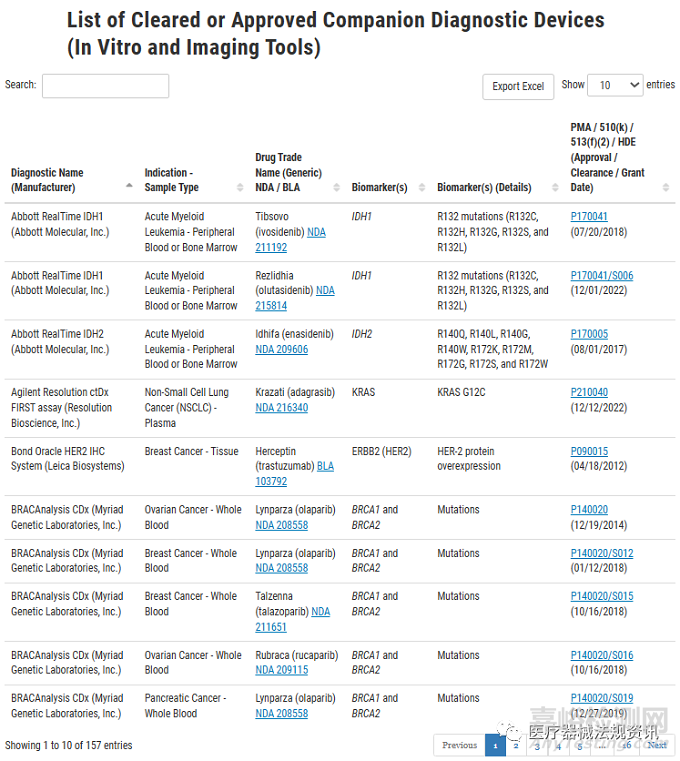在IVDR法規中,伴隨診斷產品的定義如下【Article 2,Definitions,(7)】:
‘companion diagnostic’ means a device which is essential for the safe and effective use of a corresponding medicinal product to:
“伴隨診斷產品”指的是對于相應藥品的安全和有效使用必不可少的器械,用以:
(a) identify, before and/or during treatment, patients who are most likely to benefit from the corresponding medicinal product;
在治療之前和/或治療期間,識別最有可能受益于相應藥品的患者;
or 或者
(b) identify, before and/or during treatment, patients likely to be at increased risk of serious adverse reactions as a result of treatment with the corresponding medicinal product;
在治療之前和/或治療期間,識別可能由于使用相應藥品治療而導致嚴重不良反應風險增加的患者;
在IVDR法規立法背景第(11)條指出:
Companion diagnostics are essential for defining patients' eligibility for specific treatment with a medicinal product through the quantitative or qualitative determination of specific markers identifying subjects at a higher risk of developing an adverse reaction
to the medicinal product in question or identifying patients in the population for whom the therapeutic product has been adequately studied, and found safe and effective. Such biomarker
or biomarkers can be present in healthy subjects and/or in patients.
伴隨診斷產品對于通過定量或定性確定特定標志物來確定患者是否有資格接受藥物的特定治療至關重要,該標志物用于識別對所述藥物產生不良反應的風險較高的受試者,或用于識別人群中治療產品已被充分研究并發現安全有效的患者。這樣的一種或多種生物標志物可以存在于健康受試者和/或患者中。
立法背景第(12)條指出:
(12) Devices that are used with a view to monitoring treatment with a medicinal product in order to ensure that the concentration of relevant substances in the human body is within the therapeutic window are not considered to be companion diagnostics.
用于監測藥物治療以確保人體內相關物質濃度在治療窗口內的器械,不被視為伴隨診斷產品。
但是在IVDR法規中,并沒有找到伴隨診斷產品的相關舉例。
FDA體外伴隨診斷產品指南中,對體外伴隨診斷產品的定義如下:
An IVD companion diagnostic device could be essential for the safe and effective use of a corresponding therapeutic product to:
? Identify patients who are most likely to benefit from the therapeutic product
? Identify patients likely to be at increased risk for serious adverse reactions as a result of treatment with the therapeutic product
? Monitor response to treatment with the therapeutic product for the purpose of adjusting treatment (e.g., schedule, dose, discontinuation) to achieve improved safety or effectiveness
? Identify patients in the population for whom the therapeutic product has been adequately studied, and found safe and effective, i.e., there is insufficient information about the safety and effectiveness of the therapeutic product in any other population
(這一條雖不被IVDR法規中的伴隨診斷產品定義所覆蓋,但是與IVDR法規立法背景中第(11)條的描述一致)
與IVDR法規中不同的是,FDA將“監測對治療產品治療的反應,以調整治療(如計劃、劑量、停藥),從而提高安全性或有效性”的器械也作為體外伴隨診斷產品。看上去與IVDR立法背景第(12)條的要求相悖。
那么我們來看一下FDA體外伴隨診斷產品指南中關于伴隨診斷產品的一個示例:
HER-2測試,用于確定患者是否可以接受赫賽汀(曲妥珠單抗)治療,該藥物適用于治療轉移性乳腺癌和胃癌。赫賽汀在HER-2標志物陰性人群中缺乏有效性,也有可能引起嚴重的不良反應。
目前FDA cleared或批準的伴隨診斷產品有157個:
最近的一個是Abbott RealTime IDH1,它是一種體外聚合酶鏈式反應(PCR)檢測方法,用于定性檢測從人類血液或骨髓提取的DNA中編碼五個IDH1 R132突變(R132C、R132H、R132G、R132S和R132L)的單核苷酸變體(SNV)。Abbott RealTime IDH1被認為有助于識別異檸檬酸脫氫酶-1(IDH1)突變的急性髓細胞白血病(AML)患者,用于TIBSOVO®(Ivosidenib)治療。
部分截圖如下:






